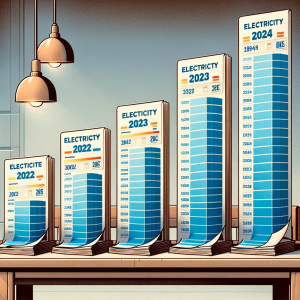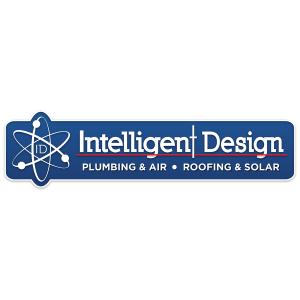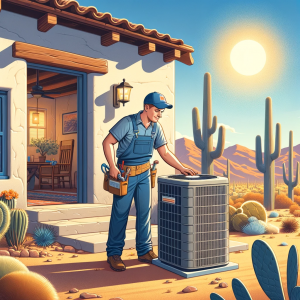
Discover why choosing a diligent AC service provider is key to system efficiency and longevity.
— Andrew Dobbins, Owner of Intelligent Design
TUCSON, AZ, UNITED STATES OF AMERICA, February 13, 2024 /EINPresswire.com/ — In a groundbreaking move that redefines excellence in air conditioning maintenance, Intelligent Design, Tucson, AZ’s premier HVAC service provider, is thrilled to announce the launch of its 82-Point AC System Inspection. This comprehensive service is meticulously designed to ensure every facet of an AC system is optimized for peak performance, energy efficiency, and longevity.
The Critical Importance of Entrusting The AC Service to a Meticulous Maintenance Provider
In the realm of home comfort, the efficiency and reliability of the air conditioning system play pivotal roles. However, not all AC maintenance services meet the high standards that today’s sophisticated systems demand. Far too often, superficial inspections fail to identify underlying issues, setting the stage for unexpected malfunctions, inflated energy costs, and a diminished lifespan of the valuable AC unit.
This reality underscores the vital importance of choosing a service provider that doesn’t merely skim the surface but delves deeply into the heart of the system with a thoroughness that leaves no stone unturned.
HVAC companies should use the revolutionary 82-point AC Tune Up inspection, it is a testament to their commitment to ensuring the home’s air conditioning is in peak condition.
Why settle for a cursory glance when the AC system deserves a comprehensive examination. The meticulous approach is designed to uncover even the most subtle signs of wear and tear, potential inefficiencies, and minor issues before they escalate into significant problems. This proactive philosophy not only safeguards the home’s comfort during the hottest days but also optimizes the system’s energy consumption, contributing to lower utility bills and a reduced environmental footprint.
A Deep Dive into the 82-Point Inspection, the inspection that every AC Tune Up company in America should be doing.
1. Energy-Saving Thermostat Check: Assess if an energy-saving thermostat is in place, crucial for optimizing energy consumption and reducing utility bills.
2. Thermostat Batteries Replacement: Batteries are replaced with homeowner-supplied units to ensure uninterrupted operation and efficiency.
3. Thermostat Mounting: The stability of the thermostat mounting on the wall is checked to prevent inaccuracies in temperature readings.
4. Floor Boot Sealing: Examine the sealing of boots to the floor, a detail that prevents air leaks and maintains system efficiency.
5. Ductwork Condition Assessment: The overall condition of the ductwork is scrutinized for leaks or damage that can hinder airflow and efficiency.
6. Ductwork Strapping and Connection: Proper strapping and connection of ducts are verified to ensure stable and efficient air distribution.
7. Return Air Size Evaluation: The size of the return air inlets is assessed to ensure they are adequate for the system’s requirements, maximizing airflow and system efficiency.
8. Return Duct Insulation: Insulation of the return ducts is inspected to minimize energy loss and enhance system efficiency.
9. Compressor Amps Logging: Compressor amperage for both start and run modes is logged, providing insights into the compressor’s health and efficiency.
10. Platform Return Sealing: The sealing of the platform return is evaluated to ensure there are no leaks, maintaining system integrity.
11. Condenser Fan Amps and Condition: The amperage draw and condition of the condenser fan are checked, key factors in the system’s cooling efficiency.
12. Ductwork Insulation Check: The insulation of the ductwork is examined for any deficiencies that could lead to energy loss.
13. Current Controller Inspection: The current controller is inspected for functionality, ensuring the system operates within safe electrical parameters.
14. Voltage Drop and Contactor Inspection: Voltage drops across the contactor are measured, and the contactors condition is assessed to prevent electrical issues.
15. Flame Sensor Cleaning: The flame sensor is cleaned to ensure reliable operation and prevent furnace malfunctions.
16. Temperature Measurements: Outdoor and indoor wet bulb temperatures are measured to assess system performance under current conditions.
17. Return Static Pressure Measurement: The static pressure in the return duct is measured, an indicator of airflow restrictions.
18. Superheat Calculation: The system’s superheat is calculated to ensure the refrigerant is at the correct temperature and pressure, indicating efficient operation.
19. Supply Static Pressure Measurement: The static pressure in the supply duct is measured to identify any blockages or airflow issues.
20. Subcool Measurement: The system’s subcool level is measured to ensure the refrigerant is properly condensing, indicating efficient operation.
21. Evaporator Coil Cleaning Assessment: The need for evaporator coil cleaning is determined, a key factor in maintaining airflow and heat exchange efficiency.
22. Wire Connections Tightening: All wire connections are tightened to ensure reliable electrical operation and prevent potential failures.
23. Evaporator Coil Condition Check: The condition of the evaporator coil is inspected for signs of wear, corrosion, or damage that could impact efficiency.
24. Start Collar Seal Inspection at Plenum: The seal of the start collar at the plenum is inspected to ensure a tight seal, preventing air leaks.
25. Start Assist Device Condition: The condition of the start assist device is checked, which can help reduce the starting load on the compressor.
26. Blower Cabinet Insulation Inspection: The insulation within the blower cabinet is inspected for integrity, ensuring minimal heat loss and noise reduction.
27. Defrost Timer Operation Test: The operation of the defrost timer is tested, crucial for preventing ice buildup on the outdoor unit in heat pump systems.
28. Blower Wheel Cleanliness Check: The cleanliness of the blower wheel is assessed, as dirt buildup can reduce efficiency and airflow.
29. Reversing Valve Operation Test: The operation of the reversing valve is tested in heat pump systems, crucial for switching between heating and cooling modes.
30. Inspector Camera Utilization: An inspector camera is used for internal inspections where direct visual access is not possible, ensuring thoroughness.
31. Coil Fins Condition Check: The condition of the coil fins is inspected for bending or damage, which can impede airflow and heat exchange.
32. Electrical Component Inspection: All electrical components are inspected for signs of wear, damage, or overheating, ensuring safe operation.
33. Refrigerant Leak Check: The system is checked for refrigerant leaks, which can significantly reduce efficiency and cooling capacity.
34. Circuit Board Burn Mark Inspection: The circuit board is inspected for burn marks, indicating potential electrical issues or component failures.
35. Blower Bearings Check: The condition of the blower bearings is inspected for wear, ensuring quiet and efficient operation.
36. Locking Caps Installation: Locking caps are installed on the service ports to prevent unauthorized access and refrigerant leaks.
37. TXV Bulb Mounting Check: The mounting of the Thermostatic Expansion Valve (TXV) bulb is checked to ensure it’s properly positioned for accurate refrigerant flow control.
38. Electrical Disconnect Condition: The condition of the electrical disconnect is inspected for safety and functionality, ensuring the system can be safely powered down.
39. Signs of Refrigerant Leaks Inspection: Additional checks for signs of refrigerant leaks are performed to ensure system integrity and environmental safety.
40. Disconnect and Circuit Breaker Lug Tightening: Lugs in the disconnect and circuit breaker are tightened to ensure a secure and safe electrical connection.
41. Primary Drain Proper Routing: The routing of the primary drain is verified to ensure proper condensate removal, preventing water damage and humidity issues.
42. Circuit Breaker Size Verification: The size of the circuit breaker is verified against the nameplate to ensure it matches the system’s electrical requirements.
43. Secondary Drain Proper Routing: The routing of the secondary drain is checked, providing a backup for condensate removal in case of primary drain failure.
44. Condensate Pump Check: The condensate pump is inspected for proper operation, ensuring condensate is effectively removed from the premises.
45. Wire Size Verification: The size of the electrical wiring to the unit is verified to ensure it meets the system’s current carrying requirements.
46. Drain Safety Switch Inspection: The drain safety switch is inspected to ensure it will shut off the system in the event of a drain blockage, preventing water damage.
47. Low Voltage Wire Condition Check: The condition of the low voltage wiring is inspected for damage or wear, ensuring reliable communication between system components.
48. Pan Treatment Necessity Assessment: The need for pan treatment to prevent algae and mold growth in the condensate pan is assessed.
49. Condensing Unit Leveling: The condensing unit is checked to ensure it is level, which is crucial for proper operation and drainage.
50. Current Controller Inspection: The current controller is re-inspected for functionality, ensuring the system operates within safe electrical parameters.
51. Shrub Clearance Around Unit: The clearance around the condensing unit is checked to ensure shrubs and debris do not impede airflow or service access.
52. Blower Motor Amps Reading: The amperage draw of the blower motor is read to assess its condition and electrical load, indicating efficiency and potential issues.
53. Line Set Insulation to Condensing Unit: The insulation of the line set running to the condensing unit is inspected to prevent energy loss and protect the lines.
54. Inducer Motor Amps Check: The inducer motor’s amperage draw is checked, important for systems with a furnace, indicating its condition and efficiency.
55. Blower Current Controller Test: The blower’s current controller is tested for functionality, ensuring the blower operates within safe electrical parameters.
56. Outdoor Unit Sticker Installation: A sticker is installed on the outdoor unit for identification, service records, and maintenance reminders.
57. Temperature Rise Measurement: The temperature rise across the furnace is measured to ensure it falls within the manufacturer’s specifications, indicating efficient operation.
58. Gas Pressure Adjustment: The gas pressure to the furnace is adjusted as necessary to ensure optimal combustion and heating efficiency.
59. Limit Switches and Mounts Check: The condition and mounting of limit switches are checked to ensure they function correctly, providing safety and operational control.
60. Burner Crossover Ports Check: The crossover ports on the burners are inspected for obstructions or damage, ensuring even gas distribution and efficient combustion.
61. Furnace Area and Burners Vacuuming: The area around the furnace and the burners themselves are vacuumed to remove dust and debris, promoting efficient operation and reducing fire risk.
62. Combustion Air Sufficiency Check: The availability of sufficient combustion air for the furnace is checked to ensure safe and efficient operation.
63. Combustion Air Vent Screen Cleaning: The screen on the combustion air vent is cleaned to ensure it is free of obstructions, maintaining proper airflow for combustion.
64. Heat Exchanger Inspection: The heat exchanger is inspected for cracks, rust, or other signs of wear, which can pose safety risks and reduce efficiency.
65. Hoses for Cracks and Wear Check: All hoses are inspected for cracks, wear, and leaks, ensuring they are in good condition to prevent gas or air leaks.
66. Pressure Switch Check: The pressure switch is checked to ensure it operates correctly, a crucial component for safety and proper furnace operation.
67. Proper Flue Rise Verification: The rise of the flue is checked to ensure it meets specifications, crucial for safe and efficient removal of combustion gasses.
68. Flue Clearances Measurement: Clearances around the flue are measured to ensure they meet safety standards, preventing heat damage and fire risks.
69. Flue Pipe Inspection for Leaks and Rust: The flue pipe is inspected for leaks, rust, and other signs of deterioration, which can compromise safety and efficiency.
70. PVC Inspection for Leaks: For systems with PVC vent pipes, these are inspected for leaks, cracks, or other signs of wear, ensuring safe and efficient venting of combustion gasses.
71. Gas Connections Leak Test: All gas connections are tested for leaks, a critical safety check to prevent gas leaks and potential hazards.
72. Flammable Material Proximity Check: The proximity of any flammable materials to the furnace is checked to ensure they are stored safely away, reducing fire risk.
73. Ignition System Operation Check: The operation of the ignition system is checked to ensure reliable starting of the furnace, crucial for efficient and safe operation.
74. Furnace Operation Test in All Stages: The furnace is run through all its stages to ensure it operates correctly across its range of settings, providing reliable heating.
75. Gas Shut Off Operation Test: The operation of the gas shut-off is tested to ensure it functions correctly, providing a means to safely disconnect the gas supply if needed.
76. Carbon Monoxide Detector Necessity Assessment: The need for a carbon monoxide detector is assessed, a critical safety device to alert occupants to the presence of CO gas.
77. Surge Protection Necessity Assessment: The need for surge protection is evaluated to protect the HVAC system from electrical surges, extending its lifespan and preventing damage.
78. UV Germicidal Lamp Necessity Assessment: The need for a UV germicidal lamp is assessed, which can improve air quality by killing bacteria and viruses in the air stream.
79. Furnace Exterior Cleaning and Waxing: The outside of the furnace is cleaned and waxed to maintain its appearance and protect its surface.
80. Filter Change or Cleaning: The air filter is changed or cleaned, a crucial maintenance step for maintaining airflow and air quality.
81. Furnace Sticker Installation: A service sticker is installed on the front of the furnace for easy reference to service dates and maintenance records.
82. Post-Operation Walkthrough with Homeowner: A comprehensive walkthrough is conducted with the homeowner to demonstrate the post-service operation of the furnace, ensuring they are informed and comfortable with their system.
For a more details on the 82 point AC Tune Up or to schedule a personalized consultation, contact:
Intelligent Design Solar, Plumbing, & Air
2200 W La Osa St
Tucson, AZ 85705
520-333-2665
[email protected]
www.idesignac.com
About Intelligent Design: A Pillar of Excellence in Home Services
Intelligent Design, under the leadership of Andrew Dobbins, a Marine Veteran renowned for his extensive expertise, has become synonymous with reliability, cutting-edge innovation, and unparalleled excellence in the HVAC sector. Established in Tucson, AZ, the company has flourished as a symbol of exceptional service, unwavering customer satisfaction, and a steadfast commitment to environmental stewardship. It remains the top choice for homeowners in search of efficient, affordable, and outstanding AC Tune Up solutions.
The team is rich in experience, bringing an average of 12 years per technician to every project, whether it involves HVAC, plumbing, solar, roofing, electrical services, or a combination of these. This depth of experience enables us to provide a comprehensive range of vital services, including air conditioning repair and installation, emergency heating services, and solutions for indoor air quality, catering to both residential and commercial clients in the Tucson area.
Proudly recognized as the highest-rated AC Tune up company in Southern Arizona, Intelligent Design is constantly striving to enhance and expand their service offerings. Their recent foray into roofing services has further cemented their status as not just the leading HVAC provider in Tucson but also as the top roofing company in the region. The extensive array of services now includes HVAC, Plumbing, Solar, Electrical, and Roofing, making us a comprehensive solution provider for all home service requirements.
Before you Google, “AC Repair Near Me”, search Intelligent Design the AC Tune Up Specialists in Tucson, AZ.
Andrew Dobbins
Intelligent Design Solar, Plumbing, Electric, & Air
+1 520-333-2665
[email protected]
Visit us on social media:
Facebook
LinkedIn
Instagram
YouTube
TikTok
AC Maintenance: How Often Should I Schedule It?
![]()
Originally published at https://www.einpresswire.com/article/688135991/intelligent-design-elevates-hvac-tune-up-standards-with-unprecedented-82-point-ac-system-inspection







